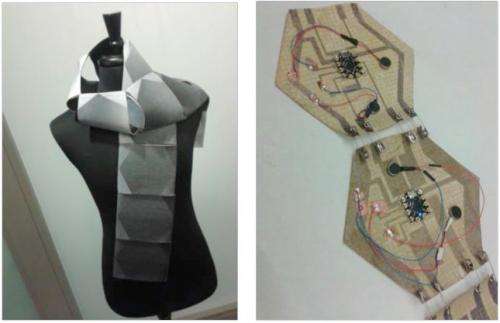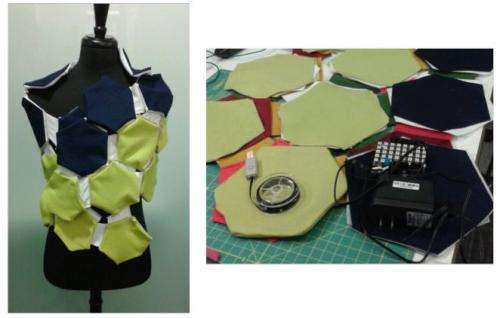January 26, 2015 weblog
Smart scarf carries multimodal language to convey emotions

A rise in wearables reflects an interest by designers and engineers to tread in self-help, fitness territory—smart watches to measure heart rates, medallions strapped to chests, biometric shirts. Now research from a University of Maryland researcher and Microsoft Research team has come up with a wearable concept that could aid in interpreting emotions. They are exploring the potential of wearable "affective technology" that may help people reflect on their own emotional state, modify their affect, and interpret the emotional states of others. The form factor is a scarf, and it is designed to respond to signals gathered from sensors via Bluetooth. People with impairments, for instance, may not receive important visual or verbal cues of others' emotions. The researchers identified six actuations to provide a multimodal language for conveying emotion – heat, cooling, music, weights, vibration, and lighting. The device can react to various emotions. They focused on basic emotions: stressed, sad, calm, happy, and excited.
They call this SWARM, short for Sensing Whether Affect Requires Mediation. For instance, in response to an excited state, SWARM could play upbeat music, or in response to stress, users could add weights to the scarf (analogous to weighted vests sometimes used in ASD therapy). The team presented a paper on their work earlier this month at the Association for Computer Machinery's conference on Tangible, Embedded and Embodied Interaction at Stanford. The paper is "SWARM: An Actuated Wearable for Mediating Affect," by Michele A. Williams, Asta Roseway, Chris O'Dowd, Mary Czerwinski and Meredith Ringel Morris. According to MIT Technology Review, Williams worked on the project while she was an intern at Microsoft Research.
"SWARM is meant to compliment a user's current strategies for coping with their emotions, and also provide more information that may not be available, particularly for users with disabilities," they wrote. They also wanted to push the boundary by exploring scenarios beyond personal emotion detection to that of interpreting others' emotions. The researchers designed their prototype after consulting with people with autism and hearing and visual disabilities.
Rachel Metz of MIT Technology Review noted that the scarf is designed to perform functions that could be "particularly useful for people who have disorders such as autism and have trouble managing their feelings." Some of the modules can heat up, while others can vibrate. She described the prototype as "a flexible laser-cut garment made of hexagons of industrial felt overlaid with conductive copper taffeta. Some of the modules can heat up, while others can vibrate." The modules are controlled by a master module also responsible for communicating with a phone app over Bluetooth.

With their intended users in mind, the team wanted to choose a form factor that did not cry out as a special assistive device but rather something more universal. They also had technical details in mind. They wrote, "We designed SWARM as a scarf for several reasons. Firstly, we were inspired by weighted vests used in ASD therapy." They said that many people with autism use pressure as a means of helping to focus and relieve the stress of sensory overload. Also, scarfs were readily used in current fashion as everyday accessories and items for warmth, and would in turn not draw extra attention as an assistive device.
Participants found merit in the scarf, said the team. "On a 1 to 7 scale of "Not Useful" to "Very Useful", survey scores averaged 5.56 for interest in a garment that reacts to emotions." They wrote that participants did feel the heat and music were mood changers, as they envisioned, and appreciated vibrations as an alert of their change in emotions.
Participants with disabilities saw the scarf as useful. The authors wrote that their probe was not in-depth enough to make strong conclusions but at the same time did indicate the need for more investigation into future uses of emotion-detection systems. As part of their future work, they wrote, they are updating the software for a wireless solution that will eventually integrate with physical sensing devices such as a heart rate monitor to generate a full emotion-detection system.
More information: SWARM: An Actuated Wearable for Mediating Affect: research.microsoft.com/apps/pu … fault.aspx?id=238353
© 2015 Tech Xplore




















